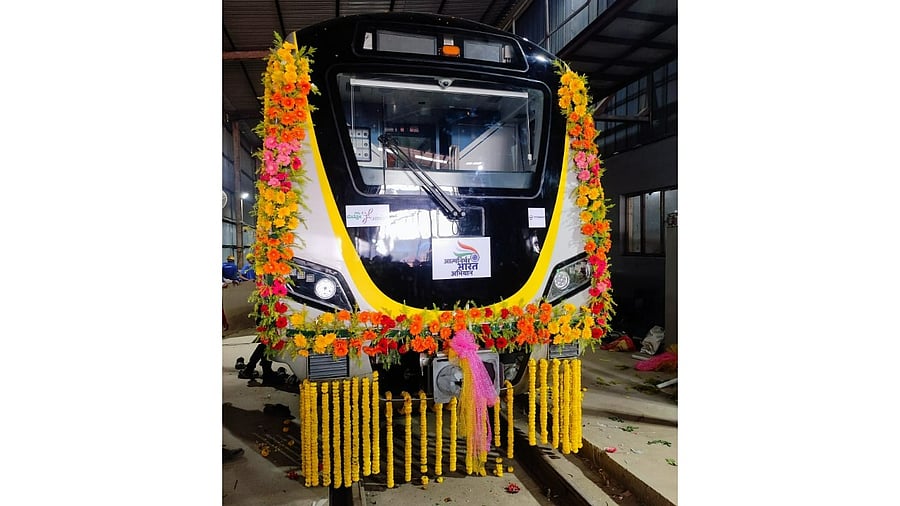
The first India-made driverless train for Namma Metro's Yellow Line rolled out from Titagarh Rail Systems Limited's (TRSL) Uttarpara plant, West Bengal, on January 6. It is expected to reach Bengaluru by road by January 20.
Credit: BMRCL
Bengaluru: Namma Metro is looking to open the Yellow Line by April with four trains but the headway could be as high as 30 minutes, a top official said.
On Monday, rolling stock manufacturer Titagarh Rail Systems Ltd (TRSL) handed over the first India-made driverless train for the 19.15-km metro line that will connect RV Road with Bommasandra via 16 stations and serve an estimated 2.5 lakh passengers per day.
The train's official handover took place at the company's plant in Uttarpara, West Bengal, in the presence of Bangalore South MP, L S Tejasvi Surya, BMRCL Director (Rolling Stock, Signalling and Electrical) MN Dhoke and other officials.
Minister for Housing and Urban Affairs Manohar Lal attended the event via video conference.
TRSL announced it would deliver two more trainsets for the Yellow Line by April, with plans to ramp up production to deliver two trains per month by September.
The six-coach train uses the Communications-Based Train Control (CBTC) signalling system for driverless operations.
TRSL is manufacturing 34 of the 36 trains as part of a Rs 1,578-crore contract awarded to China's CRRC Nanjing Puzhen Co Ltd in 2019. Of these, 15 trains are for the Yellow Line and the rest for the Purple and Green lines.
The prototype train for the Yellow Line, imported from China, arrived in Bengaluru in February 2024 and is undergoing trial runs. The prototype train for the Purple and Green lines is expected to reach the city later this month.
The six-coach train rolled out on Monday is expected to reach Bengaluru by road before January 20. It will be used for signalling tests alongside the prototype train, which could take about two weeks, BMRCL Managing Director M Maheshwar Rao said.
Based on test results, the BMRCL will invite the Commissioner of Metro Rail Safety (CMRS) for statutory inspection of the Yellow Line, Rao said.
With TRSL promising to deliver two more trains by April, Rao expressed hope about opening the Yellow Line by then.
"We believe we can begin operations with three to five trains. But having just three trains would be challenging. The headway will be high and lead to overcrowding," he told DH.
However, if TRSL supplies a total of three trains by early April, taking the total to four, the Yellow Line could become operational, he added.
"Our statutory clearances will happen simultaneously, and we'll finalise the opening date after inspections," he added.
The BMRCL aims to serve around 15,000 passengers per peak hour on the Yellow Line, a target difficult to meet with only three trains.
"Three trains can handle only about 6,000 passengers per hour," Rao explained. "We are evaluating how we can serve between 6,000 and 15,000 passengers."
Rao also stressed the need for clarity about TRSL's production schedule.
"We expected to get two trains per month from May or June. But if TRSL supplies two trains per month from September onwards, there will be delays," he said.
'Metro Mitra'
Speaking at the train handover ceremony, Khattar hailed Surya as Bengaluru's 'Metro Mitra' for championing the cause of operationalising the city’s metro network.
"He came to me repeatedly, enquiring about how metro construction in Bengaluru can be accelerated, and I assured him that all metro-related work would be duly speeded up. Surya has emerged as Bengaluru’s Metro Mitra," he said, according to a statement from the MP's office.
According to the statement, Surya facilitated stakeholder meetings and ministerial interventions to enable the early supply of car bodies for the train and obtained necessary visa clearances for Chinese engineers. He also coordinated between CRRC and software provider Melco to deliver the beta version of TCMS (Train Control Management Software) by January 2024, ahead of its earlier June 2024 timeline.